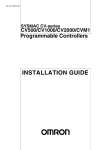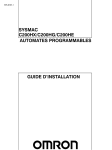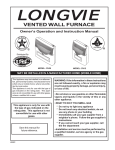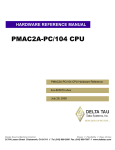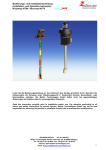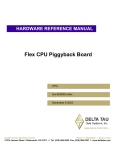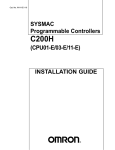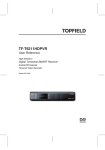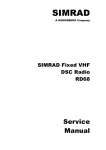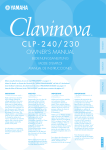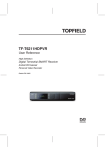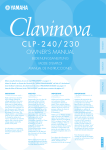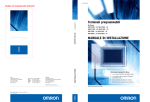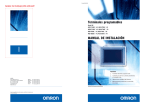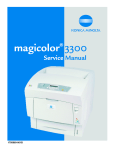Download CVM1 From CV
Transcript
CV/CVM1 Replacement Guide From CV/CVM1 to CJ2 About this document This document provides the reference information for replacing CV/CVM1 PLC systems with CJ2 series PLC. This document does not include precautions and reminders ;please read and understand the important precautions and reminders described on the manuals of PLCs (both of PLC used in the existing system and PLC you will use to replace the existing PLC) before attempting to start operation. Related Manuals CPU Units Man.No. W472 Model CJ2H-CPU6□-EIP Manual CJ2 CPU Unit Hardware USER'S MANUAL CJ2H-CPU6□ CJ2-CPU□□ W473 CJ2H-CPU6□-EIP CJ2 CPU Unit Software USER'S MANUAL CJ2H-CPU6□ CJ2M-CPU□□ W486 CJ2M-CPU□□+CH2M-MD21□ CJ2M Pulse I/O Module USER'S MANUAL W394 CS1G/H-CPU□-EV1 CS/CJ/NSJ Series PROGRAMMING MANUAL CS1G/H-CPU□□H CS1D-CPU□□H CS1D-CPU□□S CJ1H-CPU□□H-R CJ1G-CPU□□ CJ1G/H-CPU□□H CJ1G-CPU□□P CJ1M-CPU□□ W474 CS1G/H-CPU□□H CS/CJ/NSJ Series INSTRUCTIONS REFERENCE MANUAL CS1G/H-CPU□□-V1 CS1D-CPU□□H CS1D-CPU□□S CJ1H-CPU□□H-R CJ1G/H-CPU□□H CJ1G-CPU□□P CJ1M/G-CPU□□ NSJ□-□□□□(B)-□□□ W342 CS1G/H-CPU□□H CS/CJ/CP/NSJ Series Communications Commands REFERENCE MANUAL CS1G/H-CPU□□-V1 CS1D-CPU□□H CS1D-CPU□□S CS1W-SCU□□-V1 CS1W-SCB□□-V1 CJ1H-CPU□□H-R CJ1G/H-CPU□□H CJ1G-CPU□□P CJ1M/G-CPU□□ CJ1W-SCU□□-V1 CP1H-X□□□□-□ CP1H-XA□□□□-□ CP1H-Y□□□□-□ NSJ□-□□□□(B)-□□□ W202 W195 CVM1 CVM1/CV Series CV500/CV1000/CV2000/ CVM1 OPERATION MANUAL Ladder CV500/CV1000/CV2000/ Diagrams CVM1 CV-series CV500/CV1000/CV2000/CVM1 Programmable Controllers INSTALLATION CV500/CV1000/CV2000/ GUIDE CVM1D CVM1D Duplex System Programmable Controllers INSTALLATION GUIDE W351 CVM1D CVM1D Duplex System Programmable Controllers OPERATION MANUAL W227 CV500/CV1000/ FINS Commands Reference Manual W350 C200H/C1000H/C2000H/3G8F5 W203 CV Series CV Series Getting Started Guidebook Special I/O Units Man.No. W396 Model CJ1W-TC□□□ Manual CJ Series Temperature Control Units OPERATION MANUAL W401 CJ1W-CT021 CJ Series High-speed Counter Units OPERATION MANUAL W397 CJ1W-NC□□3 CJ Series Position Control Units OPERATION MANUAL W477 CJ1W-NC□□4 CJ Series Position Control Units OPERATION MANUAL W345 CS1W-AD0□□-V1/-AD161 CS/CJ Series Analog I/O Units OPERATION MANUAL CS1W-DA0□□ CS1W-MAD44 CJ1W-AD0□□-V1/-AD042 CJ1W-DA0□□/-DA042V CJ1W-MAD42 W368 CS1W-PTS□□ CS/CJ Series Analog I/O Units OPERATION MANUAL CS1W-PTW□□ CS1W-PDC□□ CS1W-PTR□□ CS1W-PPS□□ CS1W-PMV□□ CJ1W-PTS□□ CJ1W-PDC□□ CJ1W-PH41U W426 CS1W-NC□71 CS/CJ Series Position Control Units OPERATION MANUAL CJ1W-NC□71(-MA) W435 CS1W-MCH71 CS/CJ series Motion Control Units OPERATION MANUAL CJ1W-MCH71 W336 CS1W-SCB□□-V1 CS/CJ Series Serial Communications Boards Serial Communications Units CS1W-SCU□□-V1 OPERATION MANUAL CJ1W-SCU□□-V1 W440 CS1W-FLN22 CS/CJ Series FL-net Units OPERATION MANUAL CJ1W-FLN22(100BASE-TX) V236 CS1W-SPU01 CS/CJ Series SPU Units OPERATION MANUAL CS1W-SPU02-V2 CJ1W-SPU01-V2 V237 WS02-SPTC1-V2 SPU-Console OPERATION MANUAL W206 CV500-BSC11/21/31/41/51/61 CVM1/CV Series BASIC Units OPERATION MANUAL W207 CV500-BSC11/21/31/41/51/61 CVM1/CV Series BASIC Units REFERENCE MANUAL W254 CV500-MC221/421 CVM1/CV Series Motion Control Unit OPERATION MANUAL:INTRODUCTION W255 CV500-MC221/421 CVM1/CV Series Motion Control Unit OPERATION MANUAL:DETAILS Network Communications Units Man.No. W309 Model CS1W-CLK23 Manual Controller Link Units OPERATION MANUAL CS1W-CLK21-V1 CJ1W-CLK23 CJ1W-CLK21-V1 C200HW-CLK21 CVM1-CLK21 CQM1H-CLK21 CS1W-RPT0□ W370 CS1W-CLK13 Optical Ring Controller Link Units OPERATION MANUAL CS1W-CLK12-V1 CVM1-CLK12(H-PCF Cable) CS1W-CLK53 CS1W-CLK52-V1 CVM1-CLK52(GI Cable) W465 CS1W-EIP21 CS/CJ Series EtherNet/IP Units OPERATION MANUAL CJ1W-EIP21 CJ2H-CPU6□-EIP CJ2M-CPU3□ W420 CS1W-ETN21 CS/CJ Series Ethernet Units OPERATION MANUAL Construction of Networks CJ1W-ETN21 (100Base-TX) W421 CS1W-ETN21 CS/CJ Series Ethernet Units OPERATION MANUAL Construction of Applications CJ1W-ETN21(100Base-TX) W456 CS1W-CRM21 CS/CJ Series CompoNet Master Units OPERATION MANUAL CJ1W-CRM21 W457 CRT1 CRT1 Series CompoNet Slave Units and Repeater Unit OPERATION MANUAL W380 CS1W-DRM21-V1 CS/CJ Series DeviceNet Units OPERATION MANUAL W267 CS1W/CJ1W/C200HW CJ1W-DRM21 DeviceNet OPERATION MANUAL DRT1/DRT2 GT1 CVM1 W266 C200HW-SRM21-V1 CompoBus/S OPERATION MANUAL CS1W-SRM21 CJ1W-SRM21 CQM1-SRM21-V1 SRT1/SRT2 W379 CVM1-DRM21-V1 DeviceNet Master Units OPERATION MANUAL C200HW-DRM21-V1 W205 CV500-LK201 CVM1/CV Series OPERATION MANUAL: Host Link System, CV500-LK201 Host Link Unit W213 CV500-SNT31 CV-series SYSMAC NET Link SYSTEM MANUAL W242 CV500-ETN01 CV-Series Ethernet System Manual W244 CV500-TDL21 CV-Series Temperature Controller Data Link Unit OPERATION MANUAL W212 CV500-SLK11/21 CV-series SYSMAC LINK System Manual W204 CV500-RM211/221 SYSMAC BUS/2 CV-series Remote I/O SYSTEM MANUAL W348 DRT1-COM CV500-RT211/221 DeviceNet MULTIPLE I/O TERMINAL OPERATION MANUAL GT1 W434 CVM1-LK401 CV/CVM1 Series PC Link Unit OPERATION MANUAL Support Software Man.No. Model Manual W463 CXONE-AL□□C-V4 CX-One FA Integrated Tool Package SETUP MANUAL W446 CXONE-AL□□D-V4 CX-Programmer OPERATION MANUAL W447 CX-Programmer OPERATION MANUAL : Function Blocks/Structured Text W469 CX-Programmer OPERATION MANUAL SFC Programming W366 CX-Simulator OPERATION MANUAL W464 CX-Integrator OPERATION MANUAL W344 CX-Protocol OPERATION MANUAL W433 CX-Position OPERATION MANUAL W436 CX-Motion-NCF OPERATION MANUAL W448 CX-Motion-MCH OPERATION MANUAL W222 CVM1-PRS21-EV1 CVM1/CV-series Programming Console OPERATION MANUAL Read and Understand this Document Please read and understand this document before using the product. Please consult your OMRON representative if you have any questions or comments. Warranty and Limitations of Liability WARRANTY OMRON's exclusive warranty is that the products are free from defects in materials and workmanship for a period of one year (or other period if specified) from date of sale by OMRON. OMRON MAKES NO WARRANTY OR REPRESENTATION, EXPRESS OR IMPLIED, REGARDING NONINFRINGEMENT, MERCHANTABILITY, OR FITNESS FOR PARTICULAR PURPOSE OF THE PRODUCTS. ANY BUYER OR USER ACKNOWLEDGES THAT THE BUYER OR USER ALONE HAS DETERMINED THAT THE PRODUCTS WILL SUITABLY MEET THE REQUIREMENTS OF THEIR INTENDED USE. OMRON DISCLAIMS ALL OTHER WARRANTIES, EXPRESS OR IMPLIED. LIMITATIONS OF LIABILITY OMRON SHALL NOT BE RESPONSIBLE FOR SPECIAL, INDIRECT, OR CONSEQUENTIAL DAMAGES, LOSS OF PROFITS OR COMMERCIAL LOSS IN ANY WAY CONNECTED WITH THE PRODUCTS, WHETHER SUCH CLAIM IS BASED ON CONTRACT, WARRANTY, NEGLIGENCE, OR STRICT LIABILITY. In no event shall the responsibility of OMRON for any act exceed the individual price of the product on which liability is asserted. IN NO EVENT SHALL OMRON BE RESPONSIBLE FOR WARRANTY, REPAIR, OR OTHER CLAIMS REGARDING THE PRODUCTS UNLESS OMRON'S ANALYSIS CONFIRMS THAT THE PRODUCTS WERE PROPERLY HANDLED, STORED, INSTALLED, AND MAINTAINED AND NOT SUBJECT TO CONTAMINATION, ABUSE, MISUSE, OR INAPPROPRIATE MODIFICATION OR REPAIR. Disclaimers CHANGE IN SPECIFICATIONS Product specifications and accessories may be changed at any time based on improvements and other reasons. It is our practice to change model numbers when published ratings or features are changed, or when significant construction changes are made. However, some specifications of the products may be changed without any notice. When in doubt, special model numbers may be assigned to fix or establish key specifications for your application on your request. Please consult with your OMRON representative at any time to confirm actual specifications of purchased products. DIMENSIONS AND WEIGHTS Dimensions and weights are nominal and are not to be used for manufacturing purposes, even when tolerances are shown. PERFORMANCE DATA Performance data given in this manual is provided as a guide for the user in determining suitability and does not constitute a warranty. It may represent the result of OMRON's test conditions, and the users must correlate it to actual application requirements. Actual performance is subject to the OMRON Warranty and Limitations of Liability. ERRORS AND OMISSIONS The information in this manual has been carefully checked and is believed to be accurate; however, no responsibility is assumed for clerical, typographical, or proofreading errors, or omissions. Application Considerations SUITABILITY FOR USE OMRON shall not be responsible for conformity with any standards, codes, or regulations that apply to the combination of products in the customer's application or use of the products. At the customer's request, OMRON will provide applicable third party certification documents identifying ratings and limitations of use that apply to the products. This information by itself is not sufficient for a complete determination of the suitability of the products in combination with the end product, machine, system, or other application or use. The following are some examples of applications for which particular attention must be given. This is not intended to be an exhaustive list of all possible uses of the products, nor is it intended to imply that the uses listed may be suitable for the products: • Outdoor use, uses involving potential chemical contamination or electrical interference, or conditions or uses not described in this manual. • Nuclear energy control systems, combustion systems, railroad systems, aviation systems, medical equipment, amusement machines, vehicles, safety equipment, and installations subject to separate industry or government regulations. • Systems, machines, and equipment that could present a risk to life or property. Please know and observe all prohibitions of use applicable to the products. NEVER USE THE PRODUCTS FOR AN APPLICATION INVOLVING SERIOUS RISK TO LIFE OR PROPERTY WITHOUT ENSURING THAT THE SYSTEM AS A WHOLE HAS BEEN DESIGNED TO ADDRESS THE RISKS, AND THAT THE OMRON PRODUCTS ARE PROPERLY RATED AND INSTALLED FOR THE INTENDED USE WITHIN THE OVERALL EQUIPMENT OR SYSTEM. PROGRAMMABLE PRODUCTS OMRON shall not be responsible for the user's programming of a programmable product, or any consequence thereof. MEMO CV/CVM1 Replacement Guide From CV/CVM1 to CJ2 Table of Contents 1. Work flow...............................................................................................................................................................2 2. Selecting the model...............................................................................................................................................3 3. Reading data from CV/CVM1 ...............................................................................................................................6 4. Converting the program for CJ..............................................................................................................................8 5. Writing data to CJ................................................................................................................................................10 6. Appendix .............................................................................................................................................................12 Appendix A: Instruction conversion by the Change Model function of CX-Programmer ........................................12 Appendix B: Difference in data area allocation.......................................................................................................14 Appendix C: Difference in the PLC setting methods...............................................................................................15 Appendix D: Corresponding Input / Output Units....................................................................................................18 1 1. Work flow This section describes the flow of work you have to follow when you replace CV/CVM1 CPU Units with CJ-series CPU Units. Read the reference pages for details. 1) Preliminary Steps: Take the following steps before starting the replacement work. Description Start Selecting the model Preparing Units Reading PLC data Converting and modifying data Select the corresponding CJ-series Units, support software and connecting cables to be used for replacing CV/CVM1 with CJ. Some CV/CVM1 models can be used with CJ, while the others cannot. Read the reference pages to understand recommended models and precautions and select a model. Reference pages 2. Selecting the model Obtain the selected CJ-series Units, support software and connecting cables. Load the program, I/O Memory and other settings from the CV/CVM1 using the programming software and connecting cable. 3. Reading data from CV/CVM1 Convert the data read from CV/CVM1 for CJ. Most of the data can be automatically converted while some instructions are not. It depends on the used instructions or the Unit model. Refer to the reference pages and modify the data and program manually. 4. Converting and changing the program for CJ Continue actual replacement work 2) Actual replacement work flow: The following flow shows the procedure taken to replace the CV/CVM1 to CJ. Description Replacing Units Wiring Writing data to CJ Checking operation Completing the replacement 2 Replace the CV/CVM1 Units with the prepared CJ Units. * Refer to the CJ2 Series CPU Unit Hardware User’s Manual (Cat. No. W472) and User’s manual for Special I/O Units and CPU Bus Units for details about installation. Reference page Related manuals Wire the installed Units. * Refer to the CJ2 Series CPU Unit Hardware User’s Manual (Cat. No. W472) and User’s manual for Special I/O Units and CPU Bus Units for details about installation. Transfer the converted data from CV/CVM1 to CJ. To see if the wires are properly connected, operate inputs and outputs and check the signals. 4. Writing the data to CJ Turn on the power and check the operation. 1. If production is conducted between the time from when the data was read and when it was written, the present value in the program could be changed. Upload the data right before the replacement work, modify it (if necessary), and download it to the new PLC. 2. The cycle times of CV/CVM1 and of CJ are different, which may affect system operation. Adjust the cycle time from the PLC settings. Some system configuration requires additional program. Add the program, if necessary. 2. Selecting the model Outline of the system configuration SYSMAC Support Software PC CX-Programmer PC CX-Programmer CJ CV/CVM1 CV/CVM1/C500 CJ Expansion Expansion The table below lists the models of CV/CVM1 series Units and corresponding models of CJ-series Units. Select a CJ series model which is compatible with or one with similar specification to the CV/CVM1 series model you use. Refer to the following manual for details of each model. CJ2 Series CPU Unit Hardware User’s Manual (Cat. No. W472) CPU Rack Unit name CPU Units CV/CVM1 series CV500-CPU01(-V1) CVM1-CPU01(-V1/V2) CVM1-CPU11(-V1/V2) CV1000-CPU01(-V1) CV2000-CPU01(-V1) CVM1-CPU21(-V1/V2) Memory card HMC-ES[][][] (SRAM) HMC-EE[][][] (EEP-ROM) HMC-EP[][][] (EP-ROM) Expansion Data Memory CV1000-DM641 (64 KW) CV1000-DM151 (128 KW) CV1000-DM251 (256 KW) Power Supply Units CV500-PS221 CVM1-PA208 CV500-PS211 CPU Backplanes Expansion Units (I/O Control Units) Electrical Isolation Sleeve (CV500-ATT04/ATT05) CV500-BC031 (3 slots) CV500-BC053 (5 slots) CV500-BC101 (10 slots) CVM1-BC053 (5 slots) CVM1-BC103 (10 slots) CV500-IC101 CV500-IC201 CV500-IC301 CV500-ATT04 CV500-ATT05 CJ-series CJ2M-CPU14 to 15 CJ2M-CPU34 to 35 CJ2H-CPU64 CJ2H-CPU64-EIP CJ2M-CPU15 CJ2M-CPU35 CJ2H-CPU64 to 65 CJ2H-CPU64 to 65-EIP HMC-EF[][][] Unnecessary CJ1W-PA205R CJ1W-PA205C CJ1W-PA202 CJ1W-PD025 CJ1W-PD022 Unnecessary CJ1W-IC101 Unnecessary Description UM: CJ2M: 30K to 60K steps, CJ2H: 50K steps DM+EM: 160K words Number of expansions: 3 max. UM: CJ2M: 60K steps CJ2H: 50K to 100K steps. DM+EM: 160K words Number of expansions: 3 max. Flash memory type only for CJ CJ-series CPU Units have built-in EM Area. The memory capacity is different by models. Select CPU Units with enough memory capacity. AC type Note: The Power Supply Units with a RUN Output have “-R” at the end of their model No. DC type Note: No RUN Output type provided. The CJ series does not use backplane in its configuration. However, attach an End Cover (CJ1W-TER01 that is attached to the CPU Unit to the right end of the CPU Rack). The Unit is necessary when you use an expansion rack with CJ-series. The total extension length is 12 m or less. Note: No expansion exceeding 12 m is allowed. The noise-preventing spacer is unnecessary for CJ, because CJ Units are installed by isolating from the control panel. 3 Expansion Rack Unit name Power Supply Units CJ-series CJ1W-PA205R CJ1W-PA205C CJ1W-PA202 CV500-PS211 CJ1W-PD025 CJ1W-PD022 Backplanes <CPU Expansion Backplanes> Unnecessary (Expansion Backplanes) CV500-BI111 (11 slots) <I/O Expansion Backplane> CV500-BI042 (4 slots) CV500-BI062 (6 slots) CV500-BI112( 11 slots) CVM1-BI064 (6 slots) CVM1-BI114 (4 slots) < I/O Backplanes for C500 > C500-BI[][][] Expansion Units CV500-II101 CJ1W-II101 (I/O Interface Units) CV500-II201 C500-II002 Connecting Cables for < CPU Bus Cables > < CJ/CS I/O Connecting Expansion Backplanes CV500-CN311 (30 cm) Cables > CV500-CN611 (60 cm) CS1W-CN313 (30 cm) CS1W-CN713 (70 cm) CS1W-CN223 (2 m) < I/O Cables > < CJ/CS I/O Connecting CV500-CN312 (30 cm) Cables > CV500-CN612 (60 cm) CS1W-CN313 (30 cm) CV500-CN122 (1 m) CS1W-CN713 (70 cm) CV500-CN222 (2 m) CS1W-CN223 (2 m) CV500-CN322 (3 m) CS1W-CN323 (3 m) CV500-CN522 (5 m) CS1W-CN523 (5 m) CV500-CN132 (10 m) CS1W-CN133 (10 m) CV500-CN232 (20 m) CS1W-CN133-B2 (12 m) CV500-CN332 (30 m) CV500-CN432 (40 m) CV500-CN532 (50 m) < I/O Cables (for connecting < CJ/CS I/O Connecting single Expansion I/O Rack via Cables > Backplanes) > CS1W-CN313 (30 cm) CV500-CN413 (40 cm) CS1W-CN713 (70 cm) CV500-CN613 (60 cm) CS1W-CN223 (2 m) Electrical Isolation Sleeve (CV500-ATT04/ATT05) CV/CVM1 series CV500-PS221 CVM1-PA208 < I/O Cables for C500 > C500-CN312N (30 cm) C500-CN512N (50 cm) C500-CN812N (80 cm) C500-CN122N (1 m) C500-CN222N (2 m) CV500-ATT04 CV500-ATT05 Description AC type Note: RUN Output cannot be used on Expansion Racks. DC type Note: No RUN output type provided.. The CJ series does not use backplane in its configuration. However, attach an End Cover (CJ1W-TER01 that is attached to the I/O Interface Unit) to the right end of the Expansion Rack. The Unit is necessary when you use an expansion rack with CJ-series. The total extension length is 12 m or less. Note: No expansion exceeding 12 m is allowed. The cable connects a CJ-series CPU Rack or Extension Rack with another Expansion Rack. With CV/CVM1, you have to connect two cables between a CPU Unit and a CPU Expansion Rack: one is this connecting cable and the other is an I/O Cable. With CS/CJ, you need only one cable, i.e. an I/O Connection Cable for CS/CJ. With the CJ series, an I/O Interface Unit is always necessary to use an Expansion Rack. With the CJ series, an I/O Interface Unit is always necessary to use an Expansion Rack. < CJ/CS I/O Connecting With the CJ series, an I/O Interface Unit is always necessary to use an Expansion Rack. Cables > CS1W-CN313 (30 cm) CS1W-CN713 (70 cm) CS1W-CN223 (2 m) Unnecessary The noise-preventing spacer is unnecessary for CJ, because CJ Units are installed by isolating from the control panel. I/O Units & Special I/O Units Unit name Basic I/O Units Special I/O Units 4 CV/CVM1 series C500-ID/IA/IM[][][] C500-OD/OC/OA[][][] C500-MD[][][] C500-[][][][] CJ-series CJ1W-ID/IA/IM[][][] CJ1W-OD/OC/OA[][][] CJ1W-MD[][][] CJ1W-[][][][] Description Use CJ-series Basic I/O Units. The terminal block wirings and input/output specifications are different. Use CJ-series Special I/O Units. Replacement in this method involves change of the terminal block wirings and internal specifications. Communications Unit Unit name Special Units for communication CV/CVM1 series [ SYSMAC LINK ] Coaxial: CV500-SLK21 Optical Fiber Cable: CV500-SLK11 [ SYSNET ] CV500-SNT31 [ Controller Link ] Wire: CVM1-CLK21 Optical Fiber Cable: CVM1-CLK12/52 [ Host Link ] CV500-LK201 RS232C×1, RS232C/RS422 switchable ×1 [ PC Link ] CVM1-LK401 [ DeviceNet ] CVM1-DRM21(-V1) [ SYSMAC BUS ] Wire: C500-RM201. Optical Fiber Cable: C500-RM001-(P)(V1) [ SYSMAC BUS/2 ] Wire: CV500-RM221 master CV500-RT221 slave Optical Fiber Cable: CV500-RM211 master CV500-RT211 slave CJ-series [ SYSMAC LINK ] None [ Controller Link ] Wire: CJ1W-CLK23 Optical Fiber Cable: None [ SYSNET ] None [ Controller Link ] Wire: CJ1W-CLK23 Optical Fiber Cable: None [ Controller Link ] Wire: CJ1W-CLK23 Optical Fiber Cable: None Description SYSMAC LINK cannot be used with CJ-series CPU Units. We recommend you to use the Controller Link instead. Refer to Controller Link Units OPERATION MANUAL (Cat. No. W309) for details. [ Serial Communication Unit ] CJ1W-SCU21-V1(RS232×2) CJ1W-SCU31-V1 (RS422/485 × 2), CJ1W-SCU41-V1 (RS232×1, RS422/485 × 1) [ PC Link ] None [ Controller Link ] Wire: CJ1W-CLK23 Optical Fiber Cable: None [ DeviceNet ] CJ1W-DRM21 You have to change connecting cables and connectors, or modify related areas such as status area. Refer to SYSMAC CS/CJ Series Serial Communications Board Serial Communications Unit OPERATION MANUAL (Cat No. W336) for details. [ SYSMAC BUS ] None [ CompoNet ] CJ1W-CRM21 or [ DeviceNet) CJ1W-DRM21 or [ CompoBus/S ] CJ1W-SRM21 [ SYSMAC BUS/2 ] None [ CompoNet ] CJ1W-CRM21 or [ DeviceNet ] CJ1W-DRM21 or [ CompoBus/S ] CJ1W-SRM21 SUSMAC BUS cannot be used with CJ-series CPU Units. We recommend you to replace with other remote Unit (CompoNet, DeviceNet or CompoBus/S) instead. Refer to CompoNet Master Units OPERATION MANUAL (Cat. No. W456) and CRT1 Series CompoNet Slave Units and Repeater Units OPERATION MANUAL (Cat. Not. W457) for details of CompoNet. Refer to CS/CJ Series DeviceNet Units OPERATION MANUAL (Cat. No. W380) for details of DeviceNet. Refer to CompoBus/S OPERATION MANUAL (Cat. No. W266) for details of CompoBus/S. SYSNET cannot be used with CJ-series CPU Units. We recommend you to use the Controller Link instead. Refer to Controller Link Units OPERATION MANUAL (Cat. No. W309) for details. You have to modify related areas such as status. Refer to Controller Link Units OPERATION MANUAL (Cat. No. W309) for details. PC Link cannot be used with CJ-series CPU Units. We recommend you to use the Controller Link instead. Refer to Controller Link Units OPERATION MANUAL (Cat. No. W309) for details. You have to modify I/O allocation areas. Refer to DeviceNet Unit OPERATION MANUAL (Cat. No. W380) for details. SUSMAC BUS/2 cannot be used with CJ-series CPU Units. We recommend you to replace with other remote Unit (CompoNet, DeviceNet or CompoBus/S) instead. Refer to CompoNet Master Units OPERATION MANUAL (Cat. No. W456) and CRT1 Series CompoNet Slave Units and Repeater Units OPERATION MANUAL (Cat. Not. W457) for details of CompoNet. Refer to CS/CJ Series DeviceNet Units OPERATION MANUAL (Cat. No. W380) for details of DeviceNet. Refer to CompoBus/S OPERATION MANUAL (Cat. No. W266) for details of CompoBus/S. Support software and Programming devices Product Name Support software CV/CVM1 series CV Support Software SYSMAC Support Software CX-Programmer CJ-series [ CJ2H ] CX-Programmer Ver.8.0 or higher [ CJ2M ] CX-Programmer Ver.9.1 or higher Description Only CX-Programmer can be used with CJ-series CPU Units. CX-Programmer is included in Omron CX-One FA integrated Tool Package. Factory intelligent terminal PLC-PC connecting cable Programming Console (Connecting cable) FIT10 FIT20 CV500-CIF01 None Use commercially available personal computers. USB cable on the market (A connector - B Connector) None Use a cable (no longer than 5 m) for USB2.0. CV500-PRS21 (CV500-CN[][]4) Programming Console cannot be used with CJ2-series CPU Unit. Use CX-Programmer. 5 3. Reading data from CV/CVM1 Use the CX-Programmer, and read the ladder programs, PLC settings and Data Memory from the CV/CVM1. Required items Support software (PC) CX-One (CXONE-AL[][]C-V[], CXONE-AL[][]D-V[]) Or, CX-Programmer (WS02-CXPC[]-V[]) CV500-CIF01 + Conversion connector of D-SUB25 pin (female)-9 pins (female) + CS1W-CIF31 Connecting cable PC CV/CVM1 CX-Programmer Connecting cable, CV500-CIF01 D-SUB 25 pins - 9 pins conversion, CS1W-CIF31 Peripheral port (1) Mount the peripheral interface (CV500-CIF01) to the CV/CVM1 CPU unit, and connect it with the personal computer. (2) Start up the CX-Programmer. (From the Windows Start menu, select All Programs - OMRON - CX-One CX-Programmer - CX-Programmer.) (3) Select CV500, CV1000, CV2000, CVM1 or CVM1-V2 for the Device Type. (Select File – New to show the below dialog box.) (The following example selects CVM1-CPU21-V2.) (4) Connect the PLC and the CX-Programmer online. (Select PLC - Work Online) 6 (5) Load ladder programs, PLC setting and I/O table from the CV/CVM1. (Select PLC – Transfer – From PLC to PC.) Click the OK Button to read them. (6) Load the PLC memory data (Data Memory). (Select PLC – Edit - Memory.) Scroll and check all the areas. Press the Transfer From PLC Button to start loading. (7) Make the CX-Programmer offline. (Select PLC – Work online) (8) Save the program by specifying the project name. (Select File - Save As) 7 4. Converting the program for CJ On the CX-Programmer, convert the program for CJ. (1) Start the CX-Programmer, and open the program file for CV/CVM1. (Select File - Open) (2) Change the Device Type from CV/CVM1 to CJ2. (Select PLC - Change Model to show the below dialog box.) * Keep the data loaded from CV/CVM1 when you change the model to convert the program. The only data that can be converted is ladder program. The others will be cleared to default state. (3) The instructions are converted. The Output Window shows the conversion results. Double-click an error shown on the Output Window to jump to the corresponding section of the ladder program. Errors and warnings at conversion will be displayed. Double-click an error or a warning to jump to the corresponding rung section. Some instructions can not be converted. In that case, modify the ladder program according to the procedures in Appendix A. Instruction conversion by the Change Model function of CX-Programmer. You can check the program by selecting Program - Compile. The Output Window shows the checking results. Be sure to execute the Program Check because there is an instruction to which an error is not displayed when the model is changed. 8 (4) The PLC memory data cannot be maintained when the PLC model is changed. Open the PLC Memory windows for both CV/CVM1 and CJ-series PLCs, and copy the necessary memory data after conversion. Select necessary data on the PLC Memory window of CV/CVM1 CPU Unit, and paste it on the PLC memory window of CJ-series CPU Unit. (5) CV/CVM1 and CJ-series are different in the I/O allocation. Refer to Appendix B. Difference in data area allocation, and modify the ladder program. (6) CV/CVM1 and CJ-series are different in a part of PLC setting. Refer to Appendix C. Change in PLC settings, and change the PLC settings. (7) Check the program. If an error is detected, correct it. (Select Program - Compile (Program Check)) (8) Save the program by specifying the project name. (Select File - Save As) 9 5. Writing data to CJ Transfer the converted and modified programs, PLC settings and data memory to CJ-series CPU Unit. Required items Support software (PC) Connecting cable PC CX-One CXONE-AL[][]C-V[]/ AL[][]D-V[] (CX-Programmer) Commercially available USB cable CX-Programmer Connecting cable, USB cable on the market CJ2H CJ2M Peripheral port (1) Connect the CJ and the PC. (2) Start up the CX-Programmer, and open the program file for CJ that you converted or changed. (3) Connect the CJ and CX-Programmer online. (4) Transfer the ladder program. (Select PLC - Transfer – To PLC.) Select the checkbox for Program. Press the OK Button to start transfer. 10 (5) Transfer the PLC memory (Select D (Data Memory)). (Select PLC – Edit – Memory.) (6) Make the CX-Programmer offline. 11 6. Appendix Appendix A: Instruction conversion by the Change Model function of CX-Programmer (1) The data type of operand is changed from BCD to BIN data for some instructions. (2) The number of operands is changed for some instructions. (3) Interrupt control instructions must be changed. (Use MSKS, MSKR, CLI, DI, and EI.) Refer to the table below for detail. The table contains only the instructions whose states will differ by conversions. The other instructions are converted in the same state. Due to difference in CPU Unit versions or CX-Programmer versions, however, a part of these instructions can not be converted or cause different operations. Be sure to read the following related manuals and to perform operation tests to confirm that there is no problem. SYSMAC CS/CJ/NSJ Series INSTRUCTIONS REFERENCE MANUAL (Cat. No. W474) CJ2 CPU Unit Software USER’S MANUAL (Cat. No. W473) CS/CJ/NJS PROGRAMMING MANUAL (Cat. No. W394) CX-Programmer Ver9.[] OPERATION MANUAL SFC Programming (Cat. No. W469) CV/CVM1 instruction JMP(4) STEP(8) CJ-series Instruction JMP(4) or JMP0(515) JME(5) or JME0(516) STEP(8) SNXT(9) SNXT(9) EQU(25) MOVQ(37) XFER(40) MOVB(42) DIST(44) COLL(45) BXFR(46) SETA(47) =(300) MOV(21) XFERC(565) MOVBC(568) DISTC(566) COLLC(567) None SETA(530) RSTA(48) RSTA(531) NSFL(54) NSFL(578) NSFR(55) NSFR(579) NASL(56) NASL(580) NASR(57) NASR(581) NSLL(58) NSLL(582) NSRL(59) NSRL(583) ADD(70) SUB(71) MUL(72) DIV(73) ADDL(74) SUBL(75) MULL(76) DIVL(77) ADB(80) SBB(81) MLB(82) DVB(83) ADBL(84) SBBL(85) MLSL(86) DVBL(87) INC(90) DEC(91) INCB(92) DECB(93) INCL(94) DECL(95) INBL(96) DCBL(97) BCNT(114) +BC(406) -BC(416) *B(424) /B(434) +BCL(407) -BCL(417) *BL(425) /BL(435) +C(402) -C(412) *U(422) /U(432) +CL(403) -CL(413) *UL(423) /UL(433) ++B(452) --B(454) ++(448) --(450) ++BL(453) --BL(455) ++L(449) --L(451) BCNTC(621) JME(5) 12 Operand If the operand data is #0, this instruction is automatically converted to JMP0, and the operand data is deleted. In other cases, the operation remains the same. If the operand data is #0, this instruction is automatically converted to JME0, and the operand data is deleted. In other cases, the operation remains the same. The operand data must be set by Work Area (WR) or Index Resistors (indirect). Change the operand. The operand data must be set by Work Area (WR) or Index Resistors (indirect). Change the operand. Same as CV/CVM1 Same as CV/CVM1 Same as CV/CVM1 Same as CV/CVM1 Same as CV/CVM1 Same as CV/CVM1 This instruction is not supported. Consider programming with the XFER instruction. The data types of the 2nd and 3rd operands are changed from BCD to BIN. For a constant, the # mark is converted to & mark. To use word data, change the data type of word from BCD to BIN. The data types of the 2nd and 3rd operands are changed from BCD to BIN. For a constant, the # mark is converted to & mark. To use word data, change the data type of word from BCD to BIN. The data types of the 2nd and 3rd operands are changed from BCD to BIN. For a constant, the # mark is converted to & mark. To use word data, change the data type of word from BCD to BIN. The data types of the 2nd and 3rd operands are changed from BCD to BIN. For a constant, the # mark is converted to & mark. To use word data, change the data type of word from BCD to BIN. The data type of the 2nd operand is changed from BCD to BIN. For a constant, the # mark is converted to & mark. To use word data, change the data type of word from BCD to BIN. The data type of the 2nd operand is changed from BCD to BIN. For a constant, the # mark is converted to & mark. To use word data, change the data type of word from BCD to BIN. The data type of the 2nd operand is changed from BCD to BIN. For a constant, the # mark is converted to & mark. To use word data, change the data type of word from BCD to BIN. The data type of the 2nd operand is changed from BCD to BIN. For a constant, the # mark is converted to & mark. To use word data, change the data type of word from BCD to BIN. Same as CV/CVM1 Same as CV/CVM1 Same as CV/CVM1 Same as CV/CVM1 Same as CV/CVM1 Same as CV/CVM1 Same as CV/CVM1 Same as CV/CVM1 Same as CV/CVM1 Same as CV/CVM1 Same as CV/CVM1 Same as CV/CVM1 Same as CV/CVM1 Same as CV/CVM1 Same as CV/CVM1 Same as CV/CVM1 Same as CV/CVM1 Same as CV/CVM1 Same as CV/CVM1 Same as CV/CVM1 Same as CV/CVM1 Same as CV/CVM1 Same as CV/CVM1 Same as CV/CVM1 Same as CV/CVM1 Number of Operands Changes from 1 to 0, or remains the same. Changes from 1 to 0, or remains the same. Same as CV/CVM1 Same as CV/CVM1 Same as CV/CVM1 Same as CV/CVM1 Same as CV/CVM1 Same as CV/CVM1 Same as CV/CVM1 Same as CV/CVM1 Same as CV/CVM1 Same as CV/CVM1 Same as CV/CVM1 Same as CV/CVM1 Same as CV/CVM1 Same as CV/CVM1 Same as CV/CVM1 Same as CV/CVM1 Same as CV/CVM1 Same as CV/CVM1 Same as CV/CVM1 Same as CV/CVM1 Same as CV/CVM1 Same as CV/CVM1 Same as CV/CVM1 Same as CV/CVM1 Same as CV/CVM1 Same as CV/CVM1 Same as CV/CVM1 Same as CV/CVM1 Same as CV/CVM1 Same as CV/CVM1 Same as CV/CVM1 Same as CV/CVM1 Same as CV/CVM1 Same as CV/CVM1 Same as CV/CVM1 Same as CV/CVM1 Same as CV/CVM1 Same as CV/CVM1 Same as CV/CVM1 Same as CV/CVM1 Same as CV/CVM1 CV/CVM1 instruction LINE(115) CJ-series Instruction LINE(63) COLM(116) COLM(64) TCNT(123) TSR(124) None TSR(780) TSW(125) TSW(781) SSET(160) SSET(630) SRCH(164) SRCH(181) MAX(165) MAX(182) MIN(166) MIN(183) SUM(167) SUM(184) EMBC(171) EMBC(281) REGL(175) REGS(176) FPD(177) None None FPD(269) FILR(180) FILW(181) FILP(182) FLSP(183) IOSP(187) None None None None None IORS(188) None IODP(189) READ(190) None None WRIT(191) None MSG(195) MSG(46) TOUT SA(210) None SA(784) SP(211) SR(212) SF(213) SE(214) None None None SE(785) SOFF(215) CJP(221) None CJP(510) CJPN(222) CJPN(511) CNR(236) CNR(545) PID(270) PID(190) RD2(280) None WR2(281) None TST(350) TST(350) TSTN(351) TSTN(351) Operand The data type of the 2nd operand is changed from BCD to BIN. For a constant, the # mark is converted to & mark. To use word data, change the data type of word from BCD to BIN. The data type of the 2nd operand is changed from BCD to BIN. For a constant, the # mark is converted to & mark. To use word data, change the data type of word from BCD to BIN. This instruction is not supported. Consider programming with the CNT instruction. The data specification of the operand is different. Refer to the SYSMAC CS/CJ/NSJ Series INSTRUCTIONS REFERENCE MANUAL (Cat No. W474), and correct the data. The data specification of the operand is different. Refer to the SYSMAC CS/CJ/NSJ Series INSTRUCTIONS REFERENCE MANUAL (Cat No. W474), and correct the data. The data specification of the operand is different. Refer to the SYSMAC CS/CJ/NSJ Series INSTRUCTIONS REFERENCE MANUAL (Cat No. W474), and correct the data. The data specification of the operand is different. Refer to the SYSMAC CS/CJ/NSJ Series INSTRUCTIONS REFERENCE MANUAL (Cat No. W474), and correct the data. The data specification of the operand is different. Refer to the SYSMAC CS/CJ/NSJ Series INSTRUCTIONS REFERENCE MANUAL (Cat No. W474), and correct the data. The data specification of the operand is different. Refer to the SYSMAC CS/CJ/NSJ Series INSTRUCTIONS REFERENCE MANUAL (Cat No. W474), and correct the data. The data specification of the operand is different. Refer to the SYSMAC CS/CJ/NSJ Series INSTRUCTIONS REFERENCE MANUAL (Cat No. W474), and correct the data. The data type of operand is changed from BIN data to BCD. For a constant, the # mark is converted to & mark. To use word data, change the data type of word from BCD to BIN. This instruction is not supported. Consider programming with another data transfer instruction. This instruction is not supported. Consider programming with another data transfer instruction. The data specification of the operand is different. Refer to the SYSMAC CS/CJ/NSJ Series INSTRUCTIONS REFERENCE MANUAL (Cat No. W474), and correct the data. This instruction is not supported. Consider programming with the FREAD instruction. This instruction is not supported. Consider programming with the FWRIT instruction. This instruction is not supported. Consider the online editing or so. This instruction is not supported. Consider the online editing or so. This instruction is not supported. Consider selecting “Normal” for the Execution Mode of CS/CJ. (Select “Normal”.for the Execution mode on Peripheral Service tab on the PLC Settings window.). This instruction is not supported. Consider selecting “Normal” for the Execution Mode of CS/CJ. (Select “Normal”.for the Execution mode on Peripheral Service tab on the PLC Settings window.). This instruction is not supported. Consider displaying on a touch panel or so. This instruction is not supported. Consider programming with the IORD instruction. The data of the Special I/O Unit is reflected directly in the I/O memory of PLC. Please refer to the operation manual of the Special I/O Unit that you use. This instruction is not supported. Consider programming with the IOWR instruction. The data that is written to the I/O memory of PLC is directly reflected to the Special I/O Unit. Please refer to the operation manual of the Special I/O Unit that you use. The data type of the 1st operand is changed from BCD to BIN. For a constant, the # mark is converted to & mark. To use word data, change the data type of word from BCD to BIN. This instruction is not supported. Consider programming with the OUT instruction. The data specification of operand is different. Refer to the SYSMAC CS/CJ/NSJ Series INSTRUCTIONS REFERENCE MANUAL (Cat. No. W474) and CX-Programmer Ver.9.[] OPERATION MANUAL SFC Programming (Cat. No. W469), and correct the data. This instruction is not supported. Consider programming with another SFC related instruction. This instruction is not supported. Consider programming with another SFC related instruction. This instruction is not supported. Consider programming with another SFC related instruction. The data specification of operand is different. Refer to the SYSMAC CS/CJ/NSJ Series INSTRUCTIONS REFERENCE MANUAL (Cat. No. W474) and CX-Programmer Ver.9.[] OPERATION MANUAL SFC Programming (Cat. No. W469), and correct the data. This instruction is not supported. Consider programming with another SFC related instruction. The data type of operand is changed from BCD to BIN. For a constant, the # mark is converted to & mark. To use word data, change the data type of word from BCD to BIN. The data type of operand is changed from BCD to BIN. For a constant, the # mark is converted to & mark. To use word data, change the data type of word from BCD to BIN. The data specification of the operand is different. Refer to the SYSMAC CS/CJ/NSJ Series INSTRUCTIONS REFERENCE MANUAL (Cat No. W474), and correct the data. The data specification of the operand is different. Refer to the SYSMAC CS/CJ/NSJ Series INSTRUCTIONS REFERENCE MANUAL (Cat No. W474), and correct the data. This instruction is not supported. Consider programming with the IORD instruction. The data of the Special I/O Unit is reflected directly in the I/O memory of PLC. Please refer to the operation manual of the Special I/O Unit that you use. This instruction is not supported. Consider programming with the IOWR instruction. The data that is written to the I/O memory of PLC is directly reflected to the Special I/O Unit. Please refer to the operation manual of the Special I/O Unit that you use. The data type of the 2nd operand is changed from BCD to BIN. For a constant, the # mark is converted to & mark. To use word data, change the data type of word from BCD to BIN. The data type of the 2nd operand is changed from BCD to BIN. For a constant, the # mark is converted to & mark. To use word data, change the data type of word from BCD to BIN. Number of Operands Same as CV/CVM1 Same as CV/CVM1 Same as CV/CVM1 Same as CV/CVM1 Same as CV/CVM1 Same as CV/CVM1 Same as CV/CVM1 Same as CV/CVM1 Same as CV/CVM1 Same as CV/CVM1 Same as CV/CVM1 Same as CV/CVM1 Same as CV/CVM1 Same as CV/CVM1 Same as CV/CVM1 Same as CV/CVM1 It might be different. Same as CV/CVM1 Same as CV/CVM1 Same as CV/CVM1 13 Appendix B: Difference in data area allocation This table outlines the difference in the data allocation between CV/CVM1 and CJ. Refer to the related manuals for details. Item I/O allocation Basic I/O Units I/O allocation Special I/O Units I/O allocation CPU Bus Units I/O allocation SYSMAC BUS I/O allocation SYSMAC BUS/2 14 CV/CVM1-series "Free location and free words allocation" CIO 0 to 127 (The number of words differs by models.) CIO 0 to 511 (When you set the words allocated to each rack.) "Free location and free words allocation" CIO 0 to 127 (The number of words differs by models.) 0 to 511 words (When you set the words allocated to each rack.) CIO 1,500 to 1,899 (Allocates 25 words for each Unit No.) DM 2,000 to 3,599 (Allocates 100 words for each Unit No.) CIO 2,300 to 2,555 (default) CIO 200 to 999 (default) CJ-series "Free location and free words allocation" CIO 0 to 319 (The number of words differs by models.) CIO 0 to 999 (When you set the words allocated to each rack) CIO 2,000 to 2,199 (Allocates 10 words for each Unit No.) DM 20,000 to 21,999 (Allocates 100 words for each Unit No.) 1,500 to 1,899 words (Allocates 25 words for each Unit No.) DM30,000 to 31,599 (Allocates 100 words for each Unit No.) None. [ Allocation of other remote I/O ] DeviceNet: I/O allocation of CPU Bus Unit CompoNet: I/O allocation of Special I/O Unit CompoBus/S: I/O allocation of Special I/O Unit None [ Allocation of other remote I/O ] DeviceNet: I/O allocation of CPU Bus Unit CompoNet: I/O allocation of Special I/O Unit CompoBus/S: I/O allocation of Special I/O Unit [ DeviceNet for CJ ] I/O allocation of CPU Bus Unit I/O allocation DeviceNet CIO 1,900 to 1,963 CIO 2,000 to 2,063 Work Area (WR) CIO 0032(*) to 0199 (* The start word differs by models.) CIO 1,964 to 1,999 CIO 2,064 to 2,299 CIO 1,200 to 1,499 CIO 3,800 to 6,143 W000 to 511 Data Link Area 1000 to 1199 words Holding Area (HR) Temporary Relay Area (TR) CPU Bus Link Area 1000 to 1199 words D0000 to 0127 (By default) 1200 to 1499 words TR0 to 7 G000 to 255 G000 to 004: AR G008 to 255: None Auxiliary Area A000 to 511 (1) AR Area and Bit: Change the word address and bit address used in the program. (2) Condition Flag and clock pulse: Change the operation flags in the program to the condition flags and the clock pulse respectively. Use global variables such as P_0_1ms, and P_1ms instead of clock pulse. Remark Refer to CJ2 CPU Unit Software USER’s MANUAL (Cat. No. W473) for details of the I/O allocation. CJ series CPU do not support SYSMAC BUS. Consider switching to other remote I/O system. CJ series CPU do not support SYSMAC BUS/2. Consider switching to other remote I/O system. Areas unused for can be used as Work Area with CJ. However, some area will be used for future expansion. Therefore, do not use the area. H000 to 511 words TR0 to 15 CPU status and the clock have been allocated to Auxiliary Area (AR) with CJ series CPU Unit. The operation flag and the Condition Flag are specified with the label. Appendix C: Difference in the PLC setting methods This section explains the difference of PLC settings on CV/CVM1 and CJ-series CPU Units. The figure below shows the (1) setting tab on the PLC Settings window, (2) Group of settings in the tab, and (3) Setting items in each group. Check the circle and square check boxes for your settings. Be sure to confirm the system safety and system operation, though most of settings are same for both CV/CVM1 and CJ-series. (1) (2) (3) CV/CVM1 CPU Unit Startup Startup Hold - Forced Status Hold Bit CJ-series CPU Unit Startup Startup Hold - Forced Status Hold Bit Startup hold Startup Startup Hold - IOM Hold Bit Startup Startup Hold - IOM Hold Bit Startup Startup Hold - Restart Continuation Bit None Startup Mode - Program - Debug - Monitor - Run Mode Operating mode - Program - Monitor - Run - Use programming console (Run) Startup - Automatically transfer user programs None Startup display Display Mode at startup - Mode 1 - Mode 2 - Mode 3 None Error log - Enable Error Log. None Execution Controls Execution Process - Synchronous - Asynchronous Peripheral Service Sync/Async Comms Execution mode - Normal - Peripheral Service - Synchronous - Asynchronous Remark Settings to hold the force on/off status and at power interruption. If this setting is enabled, status is maintained when the power is turned on again. There is no functional difference between the CV/CVM1 and CJ. Settings to hold the I/O memory hold bits status at power interruption. The status is maintained when the power is turned on. There is no functional difference between the CV.CVM1 and CJ. Setting to hold the status of restart continuation bits at power interruption. The status is maintained when the power is turned on. There are no restart continuation bits on the CJ. Specifies the operating mode at power on. There is no debug mode on the CJ. To debug the program, use CX-Simulator. The programming console can not be used with CJ2; Operating mode can not be changed with a programming console. Specifies whether to transfer user program from the memory card at power on, or not. For CJ, it can not be set from the PLC Settings. It is set with the DIP switches on the front panel of CPU Unit. Specifies the display mode for the 7 segment indicators on the expansion unit or SYSMAC BUS/2 system. CJ series does not have this function. Consider using a touch panel to display this information, if necessary. Specifies the area to save error logs and number of logs to be saved. With CJ, error log area is fixed. Specifies whether to synchronize the execution of PLC instructions and peripheral servicing. For CJ1, select “Normal” to synchronize them and select other one for asynchronous execution. For CJ2, only “Normal” can be selected. The various execution modes as shown on the left may have different operations. Be sure to check the effect of this setting onto operation. 15 Execution Controls Indirect DM - Binary - BCD None Selects data type (Binary or BCD) to be used for Indirect DM. CJ specifies the indirect DM by using the settings below in the program. BIN mode: D with @ BCD mode : D with * Execution Controls Step Timer - 0.1 s - 1.0 s Execution controls Execution Controls 1 - Measures CPU Bus unit cycle None Settings for SFC step timer. For CJ, right-click on the SFC editor to display the setting menu. None Specifies whether to measure the CPU Bus Unit cycle time on the CPU Unit. CJ does not support this function. Note: The execution time of cycle time is saved in A262 to 268. Execution controls Execution Controls 1 - Don’t detect Low Battery CPU Settings Execute process -Do not detect Low Battery (Battery-free operation). Specifies whether to turn on the specified bit when battery error is detected with the PLC or the memory card. There is no functional difference between CV/CVM1 and CJ. Execution controls Execution Controls 1 - Run program when Bus initialize Execution controls Execution Controls 1 - Error on power off interrupts Startup Execution Setting - Start running program when initializing Unit/Inner board recognition None Specifies whether to run program when the CPU Bus Units are initializing. There is no functional difference between CV/CVM1 and CJ. Specifies whether to handle the power off interruption as non-fatal error or not. The Auxiliary Area (AR) holds the power-ON time and power-OFF time with CJ. Consider using this clock information and the FAL instruction. Specifies whether to detect duplicate action error as a non-fatal error. No duplicate action error occurs on CJ, due to difference of operation specifications. Units Execution controls Execution Controls 2 - Duplicate action error None Execution controls Execution Controls 2 - Allow multiple JPM000 use None Execution controls Execution Controls 2 - Run program on I/O verify error None Execution controls Execution Controls 2 - Startup trace enabled None Execution controls Execution Controls 2 - Nest I/O interrupts None Execution controls Execution Controls 2 - Power OFF interrupt enabled. Timings - Power Off Interrupt disabled Host Link Port Port Settings Host Link Port Communication Setting and others I/O Refresh - Zero-Cross - Cyclic - Scheduled None 16 Specifies if two or more JMP0 instruction can be used or not. Two or more JMP0 instructions can be used by default with CJ. Specifies if program is run at I/O verification error, or execution is suspended. CJ always runs program at I/O verification error. To stop the program with CJ, use the I/O verification error flag in AR Area. Settings to automatically execute trace using pre-defined settings at power on or when operating mode is changed. CJ1 does not have this setting; consider creating a ladder program to execute this function. CJ2 executes trace at power on by default. Specifies to suspend an interrupt task execution while other I/O interrupt task is being executed or execute one with higher priority first. With CJ, use MSKS instruction for this setting. Specifies whether to execute power off interrupt program (task) or not. There is not functional difference between the CV/CVM1 and CJ. Settings for built-in host link port. There is no functional difference between CV/CVM1 and CJ, when the port is used for host link. When the CJ used NT Link, select NT Link for “Mode” in this setting. (For CV, the dip switches are used for this setting.) Specifies the I/O refreshing method. Only cyclic refreshing and immediate refreshing with instructions are possible with CJ. Address Enable ・Local Racks Set the first words for Racks 0 to 7. ・Group 1 and Group 2 Set the first words for RM0 to 3. ・Group 3, RT Slaves Set the first words for RM0-RT0 to RM7-RT7. ・I/O Slaves Set the first words for RM0 to 7. Timings - Watch Cycle Time None Specify the start address of a local rack. For CJ, start address can be set on the PLCI /O Table window. CJ does not support SYSMAC BUS/2. Timings - Watch cycle time Timings - Power Off Interrupt Timings - Power OFF detection time Timings - Cycle Time Timings - Constant Cycle Time Timings - Scheduled Interrupt Interval Timings - Schedule Interrupt Interval Timings - CPU Bus Link Service None Hold - Enable Hold Area None Hold - CPU Set the hold status of Rack 0 to 7. ・Sys Bus/2 Set the hold status of RM 0 to 3. ・Sys Bus Set the hold status of RM 0 to 7. None Set the monitoring time for cycle time. There is no functional difference between the CV/CVM1 and CJ. Set the delay time to detect power interruption. There is no functional difference between the CV/CVM1 and CJ. Specifies the cycle time. The cycle time is set to the set time. There is no functional difference between the CV/CVM1 and CJ. Set the interval of scheduled interrupt. There is no functional difference between the CV/CVM1 and CJ. Settings of whether to use CPU Bus Link function. CJ does not have this function. This function is used mainly to exchange data with BASIC Unit. Consider changing the BASIC program to CPU Unit and sharing data using the global variables. Set the start address and end address of Hold area. Hold Area (Word H000 to 511) is fixed with CJ. The EM Area can be used for bit operation with CJ2, in the same way as HR Area. Set the holding status of each Rack. Holding status can not be set individually for each rack or RM with CJ. 17 Appendix D: Corresponding Input / Output Units - Input Units (1) If the terminal block or connector is different, you have to change the wiring. (2) If the input specification is not same, check if there is no problem in operation. (3) If the number of circuits is different (or increased), wire and connect the terminals and each common terminals. (4) If the internal current consumption is different, check if enough power supply capacity is provided. (5) Functionally they are supported. Refer to the related manuals for the detailed specifications. DC Input Units CV/CVM1 Unit Model: C500-ID112 Specification: 5 to12 VDC, 16 mA Terminal block, 16 points, Model: C500-ID213 Specification: 12 to 24 VDC, 10 mA Terminal block, 16 points, Model: C500-ID215 Specification: 12 to 24 VDC, 10 mA Terminal block, 32 points, Model: C500-ID218 Specification: 12 to 24 VDC, 10 mA Terminal block, 32 points Model: C500-ID218CN Specification: 12 to 24 VDC, 10 mA Connector, 32 points Model: C500-ID114 Specification: 12 VDC, 7 mA Connector, 64 points Model: C500-ID212 Specification: 24 VDC, 10 mA Terminal block, 64 points dynamic Model: C500-ID219 Specification: 12 to 24 VDC, 7 mA Connector, 64 points Corresponding CJ-series Unit Model: CJ1W-ID211 Specification: 24 VDC, 7 mA Terminal block, 16 points Model: CJ1W-ID211 Specification: 24 VDC, 7 mA Terminal block, 16 points Model: CJ1W-ID231/ID232 Specification: 24 VDC, 4.1 mA Connector, 32 points Model: CJ1W-ID231/ID232 Specification: 24 VDC, 4.1 mA Connector, 32 points Model: CJ1W-ID231/ID232 Specification: 24 VDC, 4.1 mA Connector, 32 points Model: CJ1W-ID261/ID262 Specification: 24 VDC, 4.1 mA Connector, 64 points None * Consider changing to a static type (CJ1W-ID261/ID262). Model: CJ1W-ID261/(ID262) Specification: 24 VDC, 4.1 mA Connector, 64 points TTL Input Units CV/CVM1 Unit Model: C500-ID501CN Specification: 5 VDC, 3.5 mA Connector, 32 points Corresponding CJ-series Unit None *Consider changing to the 24VDC input type (CJ1W-ID231) or the TTL I/O (CJ1W-MD563). Interrupt Input Units ..CV/CVM1 Unit Model: C2000-ID216 Specification: 12 to 24 VDC, 13 mA Terminal block, 8 points (independent common) Corresponding CJ-series Unit Model: CJ1W-INT01 Specification: 24 VDC, 7 mA Terminal block, 16 points (16 points/common) AC Input Units CV/CVM1 Unit Model: C500-IA121 Specification: 100 to 120 VAC, 10 mA Terminal block 16 points Model: C500-IA222 Specification: 200 to 240 VAC, 10 mA Terminal block, 16 points Model: C500-IA122 Specification: 100 to 120 VAC, 10 mA Terminal block. 32 points Model: C500-IA223 Specification: 200 to 240 VAC, 10 mA Terminal block, 32 points Corresponding CJ-series Unit Model: CJ1W-IA111 Specification: 100 to 120 VAC, 7 mA Terminal block, 16 points Model: CJ1W-IA201×2 Specification: 200 to 240 VAC, 9 mA Terminal block, 8 points Model: CJ1W-IA111×2 Specification: 100 to 120 VAC, 7 mA Terminal block, 16 points Model: CJ1W-IA201×4 Specification: 200 to 240 VAC, 9 mA Terminal block, 8 points AC/DC Input Units CV/CVM1 Unit Model: C500-IM211 Specification: 12 to 24 VAC/VDC,10 mA Terminal block, 16 points Model: C500-IM212 Specification: 12 to 24 VAC/VDC, 10 mA Terminal block, 32 points 18 Corresponding CJ-series Unit Model: CJ1W-ID211 Specification: 24 VDC, 7 mA, Terminal block, 16 points *When you use the AC Input Unit, change wiring for DC Input Unit. Model: CJ1W-ID231/ID232 Specification: 24 VDC, 4.1 mA, Connector, 32 points *When you use the AC Input Unit, change wiring for DC Input Unit. - Output Units (1) If the terminal block or connector is different, you have to change the wiring. (2) If the number of circuits is different (or increased), wire and connect the terminals and each common terminals. (3) If the output specification is different, check if there is no problem in operation. (4) When the used relays are different, you have to be aware that the relay service life might change depending on the usage. (Refer to the related manuals for details.) (5) If the internal current consumption is different, check if enough power supply capacity is provided. (6) If the voltage and current consumption of external power supply is different, check if enough power supply capacity is provided. (7) Functionally they are supported. Refer to the related manuals for the detailed specifications. Relay Output Units CV/CVM1 Unit Model: C500-OC221 Specification: 250 VAC/24 VDC, 2 A Terminal block, 16 points Model: C500-OC223 Specification: 250 VAC/24 VDC, 2 A Terminal block, 16 points (independent common) Model: C500-OC224 Specification: 250 VAC/24 VDC, 2 A Terminal block, 32 points Corresponding CJ-series Unit Model: CJ1W-OC211 Specification: 250 VAC/24 VDC, 2 A Terminal block, 16 points Model: CJ1W-OC201×2 Specification: 250 VAC/24 VDC, 2 A Terminal block, 8 points (independent common) Model: CJ1W-OC211×2 Specification: 250 VAC/24 VDC, 2 A Terminal block, 16 points Transistor Output Units CV/CVM1 Unit Model: C500-OD217 Specification: 12 to 24 VDC, 1 A Terminal block, 16 points Model: C500-OD219 Specification: 12 to 24 VDC, 2.1 A 16 points in which Terminal block Model: C500-OD411 Specification: 12 to 48 VDC, 1 A Terminal block, 16 points Model: C500-OD215 Specification: 24 VDC, 50 mA Terminal block, 16 points (independent common) Model: C500-OD218 Specification: 12 to 24 VDC, 0.3 A Terminal block, 32 points Model: C500-OD414 Specification: 12 to 48 VDC, 0.3 A Terminal block, 32 points Model: C500-OD412 Specification: 12 to 48 VDC, 0.3 A Terminal block, 32 points Model: C500-OD415CN Specification: 12 to 48 VDC, 0.3 A Connector, 32 points Model: C500-OD212 Specification: 12 to 24 VDC, 0.3 A Terminal block, 32 points (PNP output) Model: C500-OD211 Specification: 24 VDC, 0.1 A Terminal block, 64 points, dynamic Model: C500-OD213 Specification: 24 VDC, 0.1 A Terminal block, 64 points Corresponding CJ-series Unit Model: CJ1W-OD211 Specification: 12 to 24 VDC, 0.5 A Terminal block, 16 points Model: CJ1W-OD211 Specification: 12 to 24 VDC, 0.5 A Terminal block, 16 points Model: CJ1W-OD211 Specification: 12 to 24 VDC, 0.5 A Terminal block, 16 points Model: CJ1W-OD211 Specification: 12 to 24 VDC, 0.5 A Terminal block, 16 points (8 points/common) Model: CJ1W-OD231/OD233 Specification: 12 to 24 VDC, 0.5 A Connector, 32 points Model: CJ1W-OD231/OD233 Specification: 12 to 24 VDC, 0.5 A Connector, 32 points Model: CJ1W-OD231/OD233 Specification: 12 to 24 VDC, 0.5 A Connector, 32 points Model: CJ1W-OD231/OD233 Specification: 12 to 24 VDC, 0.5 A Connector, 32 points Model: CJ1W-OD232 Specification: 12 to 24 VDC, 0.5 A Connector, 32 points (source output) None *Consider changing to the static type (CJ1W-OD261/OD263). Model: CJ1W-OD261/OD263 Specification: 12 to 24 VDC, 0.3 A Connector, 64 points TTL Output Unit CV/CVM1 Unit Model: C500-OD501CN Specification: 5 VDC, 35 mA Connector, 32 points Corresponding CJ-series Unit None - Consider changing to a 24-VDC input type (CJ1W-OD231/OD233) or a TTL I/O (CJ1W-MD563). 19 Triac Output Units CV/CVM1 Unit Model: C500-OA121 Specification: 132 VAC, 1 A Terminal block, 16 points Model: C500-OA222 Specification: 250 VAC, 1 A Terminal block, 16 points Model: C500-OA223 Specification: 250 VAC, 1 A Terminal block, 24 points Model: C500-OA225 Specification: 250 VAC, 1 A Terminal block, 32 points Model: C500-OA226 Specification: 250 VAC, 1.2 A Terminal block, 16 points 20 Corresponding CJ-series Unit Model: CJ1W-OA201×2 Specification: 250 VAC, 0.6 A Terminal block, 8 points Model: CJ1W-OA201×2 Specification: 250 VAC, 0.6 A Terminal block, 8 points Model: CJ1W-OA201×3 Specification: 250 VAC, 0.6 A Terminal block, 8 points Model: CJ1W-OA201×4 Specification: 250 VAC, 0.6 A Terminal block, 8 points Model: CJ1W-OA201×2 Specification: 250 VAC, 0.6 A Terminal block, 8 points - Input/Output Units (1) If the terminal block or connector is different, you have to change the wiring. (2) If the input or output specification is different, check if there is no problem in operation. (3) If the number of circuits is different (or increased), wire and connect the terminals and each common terminals. (4) If the internal current consumption is different, check if enough power supply capacity is provided. (5) If the voltage and current consumption of external power supply is different, check if enough power supply capacity is provided. (6) Functionally they are supported. Refer to the related manuals for the detailed specifications. DC Input/Transistor Output Unit CV/CVM1 Unit Model: C500-MD211CN Specification: 12 to 24 VDC Input, 10 mA 12 to 24 VDC Output, 0.3 A Connector, 16 points/16 points Corresponding CJ-series Unit Model: CJ1W-MD231 Specification: 24 VDC Input, 7 mA 12 to 24 VDC Output, 0.5A Connector, 16 points/16 points 21 2011 P077-E1-01 0911(-)
































